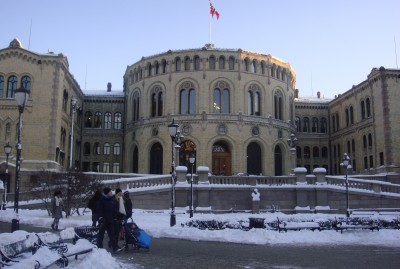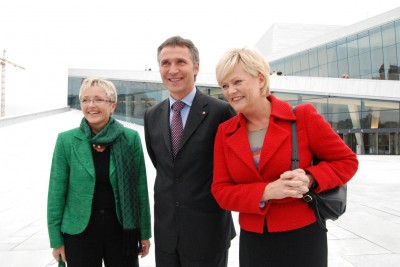 COMMENTARY: As two of Norway’s political parties consider major personnel changes, the two most striking features of Norway’s political system may be that individual lawmakers aren’t held personally accountable to voters, and that consent of the governed isn’t required to decide who actually governs, writes journalist and author Solveig Torvik (photo). This may not be a form of government that Americans, for example, immediately recognize as democratic, but it’s Norway’s take on parliamentary democracy.
COMMENTARY: As two of Norway’s political parties consider major personnel changes, the two most striking features of Norway’s political system may be that individual lawmakers aren’t held personally accountable to voters, and that consent of the governed isn’t required to decide who actually governs, writes journalist and author Solveig Torvik (photo). This may not be a form of government that Americans, for example, immediately recognize as democratic, but it’s Norway’s take on parliamentary democracy.
*****
The two countries’ political systems mirror each nation’s core values: Americans celebrate the individual while Norwegians celebrate society. Norway is a monarchy with a sovereign king while the United States is a republic with sovereign citizens. In a parliamentary monarchy, power flows from the top down. In a republic, it flows from the bottom up. This means Norway’s political system holds individual citizens further removed from their lawmakers than does the American system. Norwegians seem more inclined to defer to the wisdom of political “authorities” than do their unruly, often self-interested American counterparts.
One of the parties that makes up Norway’s coalition government held a national board meeting over the weekend, to boost support and hash out who among its leaders will run for top party posts in the spring. Ordinary voters will have no direct say in who’s chosen. Strictly speaking, individual Norwegians have no personal elected representatives as Americans understand that term. Norwegian lawmakers don’t have US-style individual constituent responsibilities because Norwegians don’t vote for a candidate, they vote for a party. Of course individual Norwegians can and do petition lawmakers, but the lobbying of lawmakers by individual citizens is not as pervasive a feature of political life as it is in the US. Compared with their constituent services-driven counterparts in the US Congress, Norwegian lawmakers – for better or worse – seem so far removed from the reach of individual citizens that they might as well be governing from the moon.

Norway qualifies as a democracy because voters do decide which of the country’s political parties should be given seats in the parliament (called Storting). Seven parties won seats in the most recent national election in 2009 and are now duly represented. But once that’s decided, Norwegian lawmakers are left to their own devices. They decide who will form a government. The Storting legally is empowered to ignore the stated will of the voters, who have, in essence, only an advisory vote. Despite what voters may say, a prime minister cannot form a government without approval of members of the Storting and formal approval of the monarch. It’s almost as if the president of the United States were chosen by, and answerable to, Congress. And even though a sitting Norwegian government may lose an election, that’s not necessarily enough to throw the bums out, despite the meddlesome fact that the citizenry wants someone else to govern. Legally only the Storting can jettison a government.
“There are in fact no limitations on the powers of parliament in this country,” stresses Hans Brattestaa, secretary general of the Storting, which has no lower house. No troublesome balance of power issues among judicial, executive and legislative branches here.

Of practical necessity, even parties overwhelmingly rejected by voters routinely are allowed to join governing coalitions in order to muster enough compatible seats to form a government; Norway hasn’t had a one-party majority government (Labour) since 1961. For example, in 2009 the tiny Center Party, with just 6.5 percent of the vote, and the Socialist Left (SV), with 8.8 percent, nonetheless were seated to govern with Labour, which had won 32.7 of the vote. In 2009, the Center Party and SV won even fewer votes (6.2 and 6.1 percent respectively). They clearly weren’t favoured by voters, but Labour could still invite them to stay in the government after it won 35.4 percent. Though incompatible with Labour, the relatively right-wing Progress Party, by way of contrast, was preferred by 22.9 percent of voters. This seems to suggest that adhering to the will of the majority of voters isn’t a high priority in Norway.
Another indication that the will of the majority isn’t a paramount concern in Norwegian political life is that one seat in the Storting, for instance, represents 7,000 citizens in sparsely populated Finnmark County, while one seat allocated to Oslo represents 18,000 citizens living there, according to the Storting’s public information office. Even though the US Senate seats also represent huge differences in political representation as well, it’s offset in the US House of Representatives, and such starkly unequal representation in Norway is a paradoxical reflection of the country’s otherwise admirable passion for equality. It seems meant to ensure that the interests of citizens in lightly populated districts not be ignored just because few people live there. While Norwegians can view the US’ Electoral College system as undemocratic, such electoral disenfranchisement as their own district voting rights (called utjevningsmandater) may seem startling to Americans, but it hasn’t been legally challenged.
Norwegian lawmakers also conduct more of the public’s business in secret than do members of Congress, whose committee deliberations are subject to open meeting rules and whose individual votes usually are recorded. But because Norwegian lawmakers normally vote as a block with their parties, tracing an individual politician’s performance can be problematic. In my view, all this contributes to a troubling accountability deficit in Norwegian political life.
So for that matter do coalition governments, which also can be found elsewhere in Scandinavia and Europe. They can blur party responsibility to the vanishing point. Moreover, many voters say they resent having the same old discredited parties, soundly trounced at the polls, re-seated as members of new governing coalitions. Is this practice really democratic?
“Probably not if you define democracy as slavishly following what the voters tell you to do,” answers Professor Hanne Marthe Narud, an expert on government accountability at the University of Oslo.
In Norway, that seems unlikely to happen any time soon.
Solveig Torvik is a Norwegian-American political journalist and author of “The World’s Best Place: Norway and the Norwegians,” available as an e-book only or printed document at www.smashwords.com.
Opinions expressed in commentaries published by “Views and News from Norway” do not necessarily reflect the views of the website but are meant to spur thought and reader response. Please offer your own views in our Reader Response feature.

